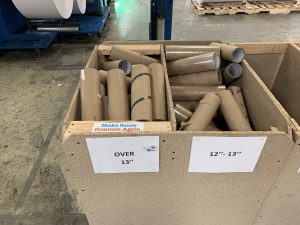A guide to recycling, upcycling and downcycling

Recycling is an act for many of us that requires little thought. We place our waste into a bin, and it is picked up by a recycle truck a few times each month. The reality is that recycling is a complicated process. By understanding how recycling works, we can make smarter decisions as brand owners to help consumers ensure their waste does not end up in a landfill. Consumers have heard of reduce, reuse, recycle, but what about upcycling and downcycling? Many are not familiar with these terms. Let’s examine each and how sustainable packaging can help brands grow their business.
What is recycling?
Recycling is the process of collecting various waste materials and turning them into the same materials. By recycling, we can keep waste out of landfills and have less demand for virgin, raw materials mined from the earth. This helps to reduce greenhouse gas emissions, energy usage, and water consumption. Recycling requires that items be sorted with other items made of the same material. This ensures that the material remains pure and can be made into the same item as the original.
Many municipalities offer recycling services to residents. What a recycling center will accept varies depending on what that facility is equipped to process. Single-source recycling centers allows residents to place all their recyclables into one bin for processing. It becomes the burden of the facility to sort the waste. If a consumer does not take the time to remove a label from a container or unscrew a cap from a bottle, it can render the waste too expensive to process and be sent to a landfill.
 What can be recycled?
What can be recycled?
Many items can be recycled including papers, aluminums, plastics and electronics. We have learned that to items must go to the proper recycle stream to prevent impurities and it is not cost-effective for a recycling facility to be setup to process everything. Check with your local recycling facility to learn what materials they do and do not take. Ask for their recommendation about how you can dispose of used batteries and electronics or other items they cannot process.
What is downcycling?
Downcycling occurs when impurities from foreign substances are not fully removed during the recycling process. These impurities can cause the material to start to break down and are a lesser quality than a new, virgin material. Many plastics breakdown each time they are recycle so they are turned into something else such as siding, carpeting and park benches.
Downcycling still helps protect the environment and keeps items out of landfills. It also doesn’t require the various types of plastics to be sorted and the plastic flakes produced are available for manufacturers to purchase to mould into something else. Most plastic can only be recycled one or two times before the plastic must be downcycled.
What is upcycling?
Upcycling is growing in the United States as people find new and creative ways to repurpose unusable objects into something more valuable and useful. Artist and crafters find items such as bottle caps, cds, or any other variety of materials and transform them into something new. Upcycling removes waste from the recycling stream completely though not all waste, such as food, is a good candidate for upcycling.
 Why Packaging Matters – Making a Change Upstream
Why Packaging Matters – Making a Change Upstream
While many towns and municipalities offer residents recycling programs, recycling is complicated. Single-source recycling programs are expensive and do not guarantee everything placed in a recycling bin is recycled. It is important for brand owners to make a change upstream and provide consumers clarity and simplified packaging. By remembering that every material requires a unique recycling stream, brand owners can rethink their current packaging solutions with a better understanding of how different components can hinder or advance how a package is recycled. Is a consumer really going to take the time to remove a label from a container prior to placing in the recycling bin? Probably not.
Many label converters and manufacturers have been working with brands for many years to find solutions to make labels advance how packaging is recycled. A growing trend is using labels featuring a wash-away adhesive. This specialty adhesive ensures that a label will release from a container cleanly during the recycling process. Other solutions include thinner face stocks and thinner liners, or sometimes no label liner at all.
The solutions for eco-friendly packaging are readily available but fear of change and the unknowns hinder many brands. The assumption is that eco-friendly is not profit friendly and while that may have been true several years ago, that is no longer the case. Thinner materials require less energy and carbon to produce, making them more cost affordable. Switching to sustainable packaging helps build brand loyalty and gain consumer trust, all while inspiring others to forge their own path to reach their sustainability goals.
